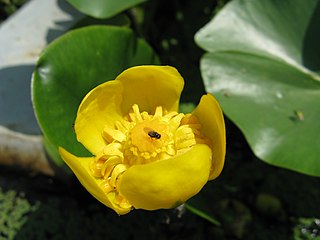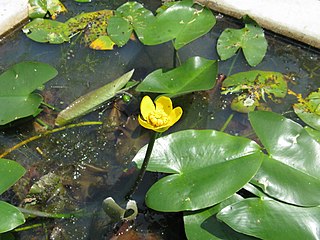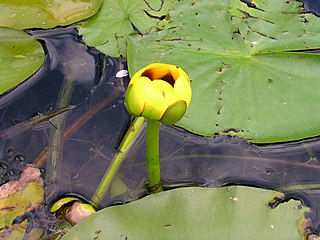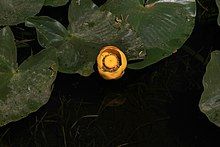
Nymphaea alba, the white waterlily, European white water lily or white nenuphar, is an aquatic flowering plant in the family Nymphaeaceae. It is native to North Africa, temperate Asia, Europe and tropical Asia.

Nelumbo lutea is a species of flowering plant in the family Nelumbonaceae. Common names include American lotus, yellow lotus, water-chinquapin, and volée. It is native to North America. The botanical name Nelumbo lutea Willd. is the currently recognized name for this species, which has been classified under the former names Nelumbium luteum and Nelumbo pentapetala, among others.

Nuphar is a genus of aquatic plants in the family Nymphaeaceae, with a temperate to subarctic Northern Hemisphere distribution. Common names include water-lily, pond-lily, alligator-bonnet or bonnet lily, and spatterdock.

Nuphar lutea, the yellow water-lily, brandy-bottle, or spadderdock, is an aquatic plant of the family Nymphaeaceae, native to northern temperate and some subtropical regions of Europe, northwest Africa, and western Asia. This species was used as a food source and in medicinal practices from prehistoric times with potential research and medical applications going forward.

Nuphar advena is a species of Nuphar native throughout the eastern United States and in some parts of Canada, such as Nova Scotia, as well as Mexico and Cuba. It is locally naturalized in Britain.

Nymphaea mexicana is a species of aquatic plant that is native to the Southern United States and Mexico as far south as Michoacán. Common names include yellow water lily, Mexican water lily and banana water lily.

Nuphar variegata is a plant in the water lily family, Nymphaeaceae. It is native to much of Canada and the northernmost of the United States.

Nuphar pumila, the least water-lily, is a perennial, rhizomatous, aquatic herb in the family Nymphaeaceae native to subarctic and temperate Eurasia.

Nuphar japonica, known as East Asian yellow water-lily, is a perennial, aquatic, rhizomatous, herb in the family Nymphaeaceae native to Japan, Korea, and Russia.

Nuphar sagittifolia, common name arrow-leaved water-lily or Cape Fear spatterdock, is a plant species known only from North Carolina, South Carolina, and Virginia.

Nuphar microphylla is a perennial, rhizomatous, aquatic herb found in North America. It is listed as a special concern and believed extirpated in Connecticut.

Nuphar subintegerrima is a species of rhizomatous aquatic plant endemic to Japan.
Nuphar ulvacea is a species of rhizomatous aquatic plant native to the US-American states Alabama and Florida.
Nuphar orbiculata is a species of rhizomatous aquatic plant native to the US-American states Alabama, Florida, and Georgia.

Nuphar × spenneriana is a species of rhizomatous aquatic plant native to Europe. It is a natural hybrid of Nuphar lutea and Nuphar pumila.

Nuphar × porphyranthera is a species of rhizomatous aquatic plant native to Great Britain. It is a hybrid of Nuphar lutea and Nuphar advena.

Nuphar × rubrodisca is a species of rhizomatous aquatic plant native to Canada and the USA. It is a natural hybrid of Nuphar variegata and Nuphar microphylla.

Nuphar pumila subsp. sinensis is a subspecies of Nuphar pumila native to China.

Nuphar sect. Astylus is a section within the genus Nuphar native to North America.

Nuphar sect. Nuphar is a section within the genus Nuphar native to Eurasia, in addition to a single North American species Nuphar microphylla.



















